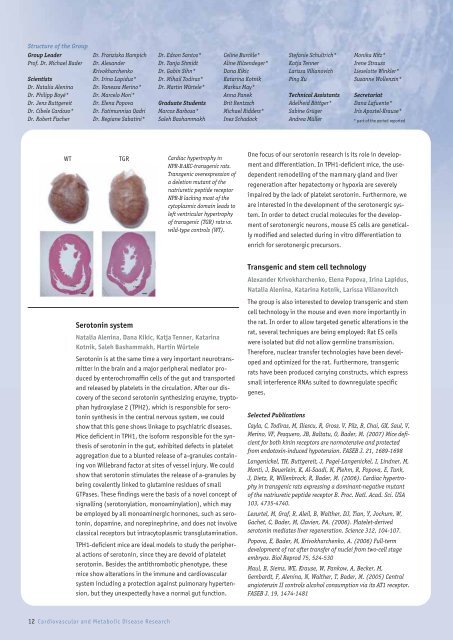of the Max - MDC
of the Max - MDC
of the Max - MDC
You also want an ePaper? Increase the reach of your titles
YUMPU automatically turns print PDFs into web optimized ePapers that Google loves.
Structure <strong>of</strong> <strong>the</strong> Group<br />
Group Leader<br />
Pr<strong>of</strong>. Dr. Michael Bader<br />
Scientists<br />
Dr. Natalia Alenina<br />
Dr. Philipp Boyé*<br />
Dr. Jens Buttgereit<br />
Dr. Cibele Cardoso*<br />
Dr. Robert Fischer<br />
Dr. Franziska Hampich<br />
Dr. Alexander<br />
Krivokharchenko<br />
Dr. Irina Lapidus*<br />
Dr. Vanessa Merino*<br />
Dr. Marcelo Mori*<br />
Dr. Elena Popova<br />
Dr. Fatimunnisa Qadri<br />
Dr. Regiane Sabatini*<br />
Dr. Edson Santos*<br />
Dr. Tanja Shmidt<br />
Dr. Gabin Sihn*<br />
Dr. Mihail Todiras*<br />
Dr. Martin Würtele*<br />
Graduate Students<br />
Marcos Barbosa*<br />
Saleh Bashammakh<br />
Celine Burckle*<br />
Aline Hilzendeger*<br />
Dana Kikic<br />
Katarina Kotnik<br />
Markus May*<br />
Anna Panek<br />
Brit Rentzsch<br />
Michael Ridders*<br />
Ines Schadock<br />
Stefanie Schultrich*<br />
Katja Tenner<br />
Larissa Vilianovich<br />
Ping Xu<br />
Technical Assistants<br />
Adelheid Böttger*<br />
Sabine Grüger<br />
Andrea Müller<br />
Monika Nitz*<br />
Irene Strauss<br />
Lieselotte Winkler*<br />
Susanne Wollenzin*<br />
Secretariat<br />
Dana Lafuente*<br />
Iris Apostel-Krause*<br />
* part <strong>of</strong> <strong>the</strong> period reported<br />
WT<br />
TGR<br />
Cardiac hypertrophy in<br />
NPR-B∆KC-transgenic rats.<br />
Transgenic overexpression <strong>of</strong><br />
a deletion mutant <strong>of</strong> <strong>the</strong><br />
natriuretic peptide receptor<br />
NPR-B lacking most <strong>of</strong> <strong>the</strong><br />
cytoplasmic domain leads to<br />
left ventricular hypertrophy<br />
<strong>of</strong> transgenic (TGR) rats vs.<br />
wild-type controls (WT).<br />
One focus <strong>of</strong> our serotonin research is its role in development<br />
and differentiation. In TPH1-deficient mice, <strong>the</strong> usedependent<br />
remodelling <strong>of</strong> <strong>the</strong> mammary gland and liver<br />
regeneration after hepatectomy or hypoxia are severely<br />
impaired by <strong>the</strong> lack <strong>of</strong> platelet serotonin. Fur<strong>the</strong>rmore, we<br />
are interested in <strong>the</strong> development <strong>of</strong> <strong>the</strong> serotonergic system.<br />
In order to detect crucial molecules for <strong>the</strong> development<br />
<strong>of</strong> serotonergic neurons, mouse ES cells are genetically<br />
modified and selected during in vitro differentiation to<br />
enrich for serotonergic precursors.<br />
Transgenic and stem cell technology<br />
Alexander Krivokharchenko, Elena Popova, Irina Lapidus,<br />
Natalia Alenina, Katarina Kotnik, Larissa Vilianovitch<br />
Serotonin system<br />
Natalia Alenina, Dana Kikic, Katja Tenner, Katarina<br />
Kotnik, Saleh Bashammakh, Martin Würtele<br />
Serotonin is at <strong>the</strong> same time a very important neurotransmitter<br />
in <strong>the</strong> brain and a major peripheral mediator produced<br />
by enterochromaffin cells <strong>of</strong> <strong>the</strong> gut and transported<br />
and released by platelets in <strong>the</strong> circulation. After our discovery<br />
<strong>of</strong> <strong>the</strong> second serotonin syn<strong>the</strong>sizing enzyme, tryptophan<br />
hydroxylase 2 (TPH2), which is responsible for serotonin<br />
syn<strong>the</strong>sis in <strong>the</strong> central nervous system, we could<br />
show that this gene shows linkage to psychiatric diseases.<br />
Mice deficient in TPH1, <strong>the</strong> is<strong>of</strong>orm responsible for <strong>the</strong> syn<strong>the</strong>sis<br />
<strong>of</strong> serotonin in <strong>the</strong> gut, exhibited defects in platelet<br />
aggregation due to a blunted release <strong>of</strong> a-granules containing<br />
von Willebrand factor at sites <strong>of</strong> vessel injury. We could<br />
show that serotonin stimulates <strong>the</strong> release <strong>of</strong> a-granules by<br />
being covalently linked to glutamine residues <strong>of</strong> small<br />
GTPases. These findings were <strong>the</strong> basis <strong>of</strong> a novel concept <strong>of</strong><br />
signalling (serotonylation, monoaminylation), which may<br />
be employed by all monoaminergic hormones, such as serotonin,<br />
dopamine, and norepinephrine, and does not involve<br />
classical receptors but intracytoplasmic transglutamination.<br />
TPH1-deficient mice are ideal models to study <strong>the</strong> peripheral<br />
actions <strong>of</strong> serotonin, since <strong>the</strong>y are devoid <strong>of</strong> platelet<br />
serotonin. Besides <strong>the</strong> antithrombotic phenotype, <strong>the</strong>se<br />
mice show alterations in <strong>the</strong> immune and cardiovascular<br />
system including a protection against pulmonary hypertension,<br />
but <strong>the</strong>y unexpectedly have a normal gut function.<br />
The group is also interested to develop transgenic and stem<br />
cell technology in <strong>the</strong> mouse and even more importantly in<br />
<strong>the</strong> rat. In order to allow targeted genetic alterations in <strong>the</strong><br />
rat, several techniques are being employed: Rat ES cells<br />
were isolated but did not allow germline transmission.<br />
Therefore, nuclear transfer technologies have been developed<br />
and optimized for <strong>the</strong> rat. Fur<strong>the</strong>rmore, transgenic<br />
rats have been produced carrying constructs, which express<br />
small interference RNAs suited to downregulate specific<br />
genes.<br />
Selected Publications<br />
Cayla, C, Todiras, M, Iliescu, R, Gross, V, Pilz, B, Chai, GX, Saul, V,<br />
Merino, VF, Pesquero, JB, Baltatu, O, Bader, M. (2007) Mice deficient<br />
for both kinin receptors are normotensive and protected<br />
from endotoxin-induced hypotension. FASEB J. 21, 1689-1698<br />
Langenickel, TH, Buttgereit, J, Pagel-Langenickel, I, Lindner, M,<br />
Monti, J, Beuerlein, K, Al-Saadi, N, Plehm, R, Popova, E, Tank,<br />
J, Dietz, R, Willenbrock, R, Bader, M. (2006). Cardiac hypertrophy<br />
in transgenic rats expressing a dominant-negative mutant<br />
<strong>of</strong> <strong>the</strong> natriuretic peptide receptor B. Proc. Natl. Acad. Sci. USA<br />
103, 4735-4740.<br />
Lesurtel, M, Graf, R, Aleil, B, Wal<strong>the</strong>r, DJ, Tian, Y, Jochum, W,<br />
Gachet, C, Bader, M, Clavien, PA. (2006). Platelet-derived<br />
serotonin mediates liver regeneration. Science 312, 104-107.<br />
Popova, E, Bader, M, Krivokharchenko, A. (2006) Full-term<br />
development <strong>of</strong> rat after transfer <strong>of</strong> nuclei from two-cell stage<br />
embryos. Biol Reprod 75, 524-530<br />
Maul, B, Siems, WE, Krause, W, Pankow, A, Becker, M,<br />
Gembardt, F, Alenina, N, Wal<strong>the</strong>r, T, Bader, M. (2005) Central<br />
angiotensin II controls alcohol consumption via its AT1 receptor.<br />
FASEB J. 19, 1474-1481<br />
12 Cardiovascular and Metabolic Disease Research
















